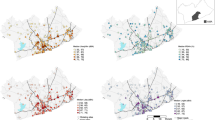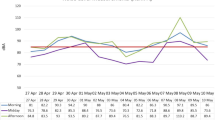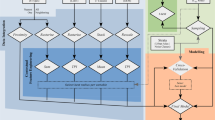Abstract
Background
Environmental low frequency noise (LFN < 125 Hz), ubiquitous in urban areas, is an understudied area of exposure science and an overlooked threat to population health. Environmental noise has historically been measured and regulated by A-weighted decibel (dBA) metrics, which more heavily weight frequencies between 2000 and 5000 Hz. Limited research has been conducted to measure and characterize the LFN components of urban environmental noise.
Objectives
We characterized LFN noise at two urban sites in Greater Boston, Massachusetts (USA) using dBA and full spectrum noise measurements with aims to (1.) analyze spatio-temporal differences in the two datasets; (2.) compare and contrast LFN metrics with dBA noise metrics in the two sites; and (3.) assess meteorological covariate contributions to LFN in the dataset.
Methods
We measured A- and C-weighted, and flat, unweighted noise levels and 1/3-octave band continuously for 5 months using sound level meters sampling at f = 1 Hz and we recorded sound samples at 44.1 kHz. Our measurement sites were located in two urban, densely populated communities, burdened by close proximity to bus, rail, and aircraft routes.
Results
We found that (1.) LFN does not follow the same seasonal trends as A-weighted dBA loudness; there are spatial differences in LFN and its very low frequency noise components (VLFN) between two urban sites; (2.) VLFN and LFN are statistically significant drivers of LCeq (nearly independent of frequency) minus LAeq, (LCeq-LAeq) >10 dB, an accepted LFN metric; and (3.) LFN was minimally affected by high wind speeds at either Site.

Impact Statement
-
Environmental low-frequency noise (LFN < 125 Hz), ubiquitous in urban areas, is an understudied area of exposure science and an overlooked risk to population health. We measured environmental noise across the full spectrum of frequencies continuously for five months at two urban sites located in Environmental Justice communities. We found that LFN did not follow the same seasonal trends as A-weighted (dBA) loudness, and we observed spatial differences in LFN and very low frequency noise (VLFN < 20 Hz) at the two sites. Not characterizing LFN and basing noise regulations only on A-weightings, a poor predictor of LFN, may expose populations to LFN levels of concern.
This is a preview of subscription content, access via your institution
Access options
Subscribe to this journal
Receive 6 print issues and online access
$259.00 per year
only $43.17 per issue
Buy this article
- Purchase on Springer Link
- Instant access to full article PDF
Prices may be subject to local taxes which are calculated during checkout



Similar content being viewed by others
Data availability
The data generated and analyzed during this study are available from the corresponding author on reasonable request.
References
Selander J, Bluhm G, Theorell T, Pershagen G, Babisch W, Seiffert I, et al. Saliva cortisol and exposure to aircraft noise in six European countries. Environ Health Perspect. 2009;117:1713–7.
Haralabidis AS, Dimakopoulou K, Vigna-Taglianti F, Giampaolo M, Borgini A, Dudley M-L, et al. Acute effects of night-time noise exposure on blood E.D. Walker et al. Environmental Research 159 (2017) 491–499 498 pressure in populations living near airports. Eur Heart J 2008;29:658–64. https://doi.org/10.1093/eurheartj/ehn013.
Bodin T, Albin M, Ardo J, Stroh E, Ostergren P-O, Bjork J. Road traffic noise and hypertension: results from a cross-sectional public health survey in southern Sweden. Environ Health. 2009;8:38–47. https://doi.org/10.1186/1476-069X-8-38.
Babisch W, Beule B, Schust M, Kersten N, Ising H. Traffic noise and risk of myocardial infarction. Epidemiology. 2005;16:33–40. https://doi.org/10.1097/01.ede.0000147104.84424.24.
Floud S, Vigna-Taglianti F, Hansell A, Blangiardo M, Houthuijs D, Breugelmans O, et al. Medication use in relation to noise from aircraft and road traffic in six European countries: results of the HYENA study. Occup Environ Med 2011;68:7.
Hansell AL, Blangiardo M, Fortunato L, Floud S, de Hoogh K, Fecht D, et al. Aircraft noise and cardiovascular disease near Heathrow airport in London: small area study. Br Med J. 2013;347. https://doi.org/10.1136/bmj.f5432.
Correia AW, Peters JL, Levy JI, Melly S, Dominici F. Residential exposure to aircraft noise and hospital admissions for cardiovascular diseases: multi-airport retrospective study. Br Med J. 2013;347:f5561. https://doi.org/10.1136/bmj.f5561.
Münzel T, Sørensen M, Schmidt F, Schmidt E, Steven S, Kröller-Schön S, et al. The adverse effects of environmental noise exposure on oxidative stress and cardiovascular risk. Antioxid Redox Signal. 2018;28:873–908.
Münzel T, Gori T, Babisch W, Basner M. Cardiovascular effects of environmental noise exposure. Eur Heart J. 2014;35:829–36.
Walker ED, Brammer A, Cherniack MG, Laden F, Cavallari JM. Cardiovascular and stress responses to short-term noise exposures—A panel study in healthy males. Environ Res. 2016;150:391–7.
Waye KP, Clow A, Edwards S, Hucklebridge F, Rylander R. Effects of nighttime low frequency noise on the cortisol response to awakening and subjective sleep quality. Life Sci. 2003;72:863–75.
Verzini AM, Frassoni CA, Ortiz AH. A field study about the effects of low‐frequency noise on man. J Acoustical Soc Am. 1999;105:942–2.
Branco NAC, Alves-Pereira M, Araújo A, Reis J. Environmental Vibroacoustic Disease–an Example of Environmental Low Frequency Noise Exposure. Sound Vib. 2005;11:14.
Araújo Alves J, Neto Paiva F, Torres Silva L, Remoaldo P. Low-frequency noise and its main effects on human health—A review of the literature between 2016 and 2019. Appl Sci. 2020;10:5205.
Ascari E, Licitra G, Teti L, Cerchiai M. Low frequency noise impact from road traffic according to different noise prediction methods. Sci Total Environ. 2015;505:658–69.
Waye KP. Effects of Low Frequency Noise and Vibrations: Environmental and Occupational Perspectives, in Encyclopedia of Environmental Health, Elsevier, 2011, pp. 240–53. https://doi.org/10.1016/B978-0-444-52272-6.00245-2.
Glazener A, Sanchez K, Ramani T, Zietsman J, Nieuwenhuijsen MJ, Mindell J, et al. Fourteen pathways between urban transportation and health: A conceptual model and literature review. J Transp Health. 2021;21:101070.
Frank LD, Iroz-Elardo N, MacLeod KE, Hong A. Pathways from built environment to health: A conceptual framework linking behavior and exposure-based impacts. J Transp Health. 2019;12:319–35.
Hasegawa Y, Lau SK. A qualitative and quantitative synthesis of the impacts of COVID-19 on soundscapes: A systematic review and meta-analysis. Sci Total Environ. 2022;844:157223.
MASSDEP, 2020. Environmental Justice Communities in Massachusetts. Retrieved from. https://www.mass.gov/info-details/environmental-justice-communities-in-massachusetts.
Mass Department of Transportation (MADOT), 2016 mhd.public.ms2soft.com/tcds.
Massachusetts Bay Transportation Authority, www.MBTA.com.
Massachusetts Port Authority, www.massport.com.
City of Boston, (MA), www.bostonplans.org.
Volpe National Transportation Systems Center, US Department of Transportation, Cambridge, MA, USA PARTNER, Sleep Study #25 Acoustics System, 2014.
General Edward Lawrence Logan International Airport (KBOS) http://www.airnav.com/airport/bos.
Goelzer B. cited in Hansen, C. H. (2001). Fundamentals of acoustics. Occupational Exposure to Noise: Evaluation, Prevention and Control. World Health Organization, 1, 23-52.
The Mathworks, www.mathworks.com.
Boston University Medical Center (BUMC) IMP Amendment/Large Project Review, Howard Stein Hudson, 2013.
Boston Public School 2016-17 District Calendar, BostonPublicSchools.org.
WHO. Guidelines for Community Noise. Geneva: World Health Organization; 1999.
Roberts C. Ecoaccess guideline for the assessment of low frequency noise. In Proceedings of acoustics, Vol. 4, 2004.
US Environmental Protection Agency (USEPA), “EPA_levels_doc1978.pdf.”
Hurtley C, World Health Organization. Night noise guidelines for Europe. Copenhagen, Denmark: World Health Organization Europe; 2009. Eds.
World Health Organization. Environmental noise guidelines for the European region. World Health Organization. Regional Office for Europe, 2018.
Roberts C. Low frequency noise from transportation sources. In Proceedings of the 20th International Congress on Acoustics. Sydney, Australia; 2010, pp. 23–27.
Wang T, Jiang R, Lin YE, Monahan K, Leaffer D, Doroff S, et al. Scalable Machine Learning Approach to Classifying Transportation Noise at Two Urban Sites in Greater Boston, Massachusetts. In INTER-NOISE and NOISE-CON Congress and Conference Proceedings (Vol. 263, No. 1, pp. 4962–4974), Washington, D.C.: Institute of Noise Control Engineering; 2021.
Walker ED, Hart JE, Koutrakis P, Cavallari JM, VoPham T, Luna M, et al. Spatial and temporal determinants of A-weighted and frequency specific sound levels—An elastic net approach. Environ Res. 2017;159:491–9.
Walker ED, Lee NF, Scammell MK, Feuer AP, Power MB, Lane KJ, et al. Descriptive characterization of sound levels in an environmental justice city before and during a global pandemic. Environ Res. 2021;199:111353.
Berglund B, Hassmen P, Job RS. Sources and effects of low‐frequency noise. J Acoustical Soc Am. 1996;99:2985–3002.
Leventhall G, Pelmear P, Benton S. A review of published research on low frequency noise and its effects. University of Westminster, UK. Department for Environment, Food and Rural Affairs; 2003.
Wang LM, Kraay B. “Rating low levels of ambient noise in performing arts facilities.” Proceedings of the International Symposium on Room Acoustics; Toronto, Canada; June 9–11, 2013.
Wang VS, Lo EW, Liang CH, Chao KP, Bao BY, Chang TY. Temporal and spatial variations in road traffic noise for different frequency components in metropolitan Taichung, Taiwan. Environ Pollut. 2016;219:174–81.
Sandberg U, Ejsmont JA. ‘Tyre/Road Noise Reference Book’. Kisa, Sweden. Sa: Informex HB; 2002.
Tombolato A, Bonomini F, Di Bella A. Methodology for the evaluation of low-frequency environmental noise: A case-study. Appl Acoust. 2022;187:108517.
Ragettli MS, Goudreau S, Plante C, Fournier M, Hatzopoulou M, Perron S, et al. Statistical modeling of the spatial variability of environmental noise levels in Montreal, Canada, using noise measurements and land use characteristics. J Exposure Sci Environ Epidemiol. 2016;26:597–605.
Casey JA, Morello-Frosch R, Mennitt DJ, Fristrup K, Ogburn EL, James P. Race/ethnicity, socioeconomic status, residential segregation, and spatial variation in noise exposure in the contiguous united states. Environ Health Perspect. 2017:125. https://doi.org/10.1289/EHP898.
Brugge D, Ron S, Reisner E, Botana P, Leaffer D, Zamore W, et al. Noise Barriers in Somerville: A Health Lens Analysis (HLA). Environ Epidemiol. 2019;3:44.
Burger J. Trust and consequences: Role of community science, perceptions, values, and environmental justice in risk communication. Risk Anal. 2022;42:2362–75.
Health of Boston, Snehal N. Shah, MD, MPH Director, Research and Evaluation Office, BPHC, 2016/2017 www.boston.gov.
Healthy Chicago 2025, https://www.chicago.gov/content/dam/city/depts/cdph/statistics_and_reports/HC2025_917_FINAL.pdf.
Loh P, Sugerman-Brozan J, Wiggins S, Noiles D, Archibald C. From asthma to AirBeat: community-driven monitoring of fine particles and black carbon in Roxbury, Massachusetts. Environ Health Perspect. 2002;110:297–301. suppl 2.
Acknowledgements
The authors thank the Volpe National Transportation Systems Center, US Department of Transportation, Cambridge, MA, USA for their equipment loan.
Author information
Authors and Affiliations
Contributions
Individual contributions of authors to the manuscript are acknowledged as follows: JD contributed to design of study and equipment QA/QC, and draft manuscript editing and revisions; HS contributed to statistical analysis and modeling; BT contributed to noise analytics, MATLAB scripting and manuscript editing and revisions; CR contributed to equipment training and field program design and specifications; DG contributed to manuscript development, editing and project realization. Others acknowledged as contributory to this study include Aaron Hastings, Ph.D., Lawrence McKenna, Ph.D., Saby Ghoshray, Ph.D., Jens Burgert, Ph.D., Neelakshi Hudda, Ph.D., Matthew Simon, Ph.D., Elliott M. Familant, Ph.D., Doug Brugge, Ph.D., Carolyn Talmadge, Wig Zamore, Juan Oscar Azaret, Kyle Monahan, Paul Marcantonio, Steve Doroff, Grace Wang, Jen Welsh, James Ghassibi and Lance Hidy.
Corresponding author
Ethics declarations
Competing interests
The authors declare no competing interests.
Additional information
Publisher’s note Springer Nature remains neutral with regard to jurisdictional claims in published maps and institutional affiliations.
Supplementary information
Rights and permissions
Springer Nature or its licensor (e.g. a society or other partner) holds exclusive rights to this article under a publishing agreement with the author(s) or other rightsholder(s); author self-archiving of the accepted manuscript version of this article is solely governed by the terms of such publishing agreement and applicable law.
About this article
Cite this article
Leaffer, D.J., Suh, H., Durant, J.L. et al. Long-term measurement study of urban environmental low frequency noise. J Expo Sci Environ Epidemiol (2023). https://doi.org/10.1038/s41370-023-00599-x
Received:
Revised:
Accepted:
Published:
DOI: https://doi.org/10.1038/s41370-023-00599-x



